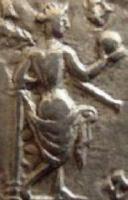

by Jim Phelps
Victorious Venus. These coins exhibit a single scene from a Greek legend which, but the time these coins were produced, is already well over 1000 years old. Given the number of emperors and empresses who minted coins with this particular reverse design, we must guess that this was a representation of a famous statue, but as yet I've been unable to find mention of one.
At the wedding of King Peleus and the sea-nymph Thetis all of the gods were in attendance, with one notable exception. Eris, the goddess of Strife, had not been invited. Enraged at being excluded and true to her nature, she caused discord. The goddess flung a golden apple among the guests with the inscription "For the fairest." Three goddesses laid claim to this - Hera (Juno), Athena (Diana), and Aphrodite (Venus).
The three asked for father Zeus to judge between them, but wisely he declined, knowing that there was no way to win. He ordered Hermes to go to the shepherd Paris on Mount Ida to judge. King Priam of Troy had been warned that his son would some day cause the ruin of his country, so he had sent him away. The son, Paris, was living with the nymph Oenone at the time of the Judgement.
Since it is impossible for a mortal to judge the perfect beauty of a goddess, each came offering him gifts appropriate to her domain. Hera offered dominion over all lands and great riches. Athena offered victory in battle, with Paris leading the Trojans to victory against the Mycenaean Greeks. Aphrodite offered him the love of the most beautiful woman. Oenone wisely knew that any decision would be disastrous, but advised Paris to choose Athena. To the ruin of all, he chose the gifts of Aphrodite and offered her the apple.
The most beautiful woman in the world was Helen, wife of King Menelaus of Sparta. Paris went to Greece and stayed in the hall of Menelaus. Helen instantly fell in love with him and they fled to Troy together. Not only had he stolen another man's wife, but he had also broken the sacred laws of hospitality. King Menelaus and his allies immediately declared war on Troy, the legendary cause of the Trojan War immortalized by the Homeric Poems, The Iliad and The Odyssey.
Paris does not fare well in the war. After killing Achilles he is wounded by an arrow. He calls on Oenone, the nymph he had spurned to heal him but she refuses and allows him to die. She later kills herself. Helen is reunited with Menelaus at the end of the war and returns to Sparta. The Odyssey revisits the home of Menelaus years later, as Odysseus enjoys the hospitality of the king and queen.
The legend can be possibly be dated by observing the goddesses included. Both Hera and Aphrodite seem to have been Minoan goddesses, but Athena is a later arrival in Greece having been introduced by the Mycenaean culture. The original depictions of the legend on early Greek pottery show the three goddesses robed, offering gifts to Paris. It was through later artists that the legend seemed to devolve into a beauty contest, with the three shown nude. Since a mortal would be unable to judge the perfect beauty of a goddess this method of display is illogical, yet reflects the art of the times. The fact that Artemis is not included in the original depictions of the legend can be used to date the popular version of the legend. She was of Anatolian origin and was a minor deity in the Greek pantheon early on, but she is later included by Homer in a brief mention of the tale in book 20 of The Odyssey.
AR Denarius
Obv: T CAESAR IMP VESPASIANVS - Laureate bust right.
Rev: TR POT VIII COS VII - Venus standing half-right (facing away) leaning on a column, naked to waist, holding a helmet and a transverse spear.
This example minted 66-67, though other years are known.
Van Meter 34, SRCV -, RIC II 205d
AR Denarius
Obv: IVLIA DOMNA AVG - Draped bust right.
Rev: VENERI VICTR - Venus standing half-right (facing away), naked to waist, holding an apple and a palm frond over her left shoulder, resting her left elbow on a column.
Issued 193-196, right at the beginning of her husband Septimius Severus' reign by the mint of Rome. Note the Emesa mint example which shows the less-common obverse legend of "IVLA..."
Van Meter 49, SRCV -, RSC III 194, RIC IV 536
Mint of Rome:
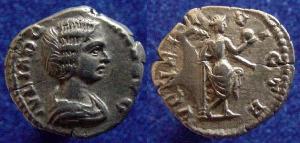
Mint of Emesa:
Barbaric Mint: 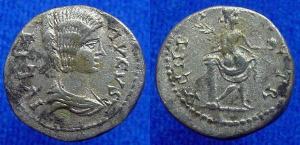
AE or base AR Antoninianus
Obv: SALONINA AVG - Draped bust right wearing a diadem, before crescent.
Rev: VENVS VICTRIX - Venus standing half-right (facing away), holding an apple (or a helmet, in some references), a palm frond crossing in front of her, resting her left elbow on a column.
For Salonina, this type seems to have only been minted in Lugdunum, and only during the joint reign period of 253-260.
Van Meter -, SRCV -, RSC IV 134, RIC V 8 sim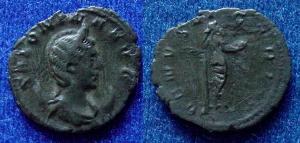
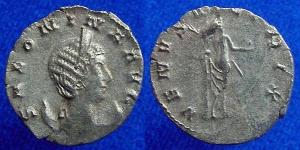
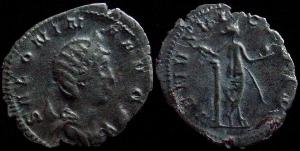
The following catalogue references are used for the coins on this page:
Van Meter - "The Handbook of Roman Imperial Coins" by David Van Meter (1991) - My favorite general reference.
SRCV - "Roman Coins and Their Values" - by David Sear (1988)
RSC III - "Roman Silver Coins" Part III - by H.A. Seaby and David R. Sear (1982)
RSC IV - "Roman Silver Coins" Part IV - by H.A. Seaby and David R. Sear (1982)
RIC IV - "Roman Imperial Coinage" Volume IV, part 1 - by Mattingly and Sydenham (1936)
RIC V - "Roman Imperial Coinage" Volume 5, part 1 - by Mattingly and Sydenham (1936)












